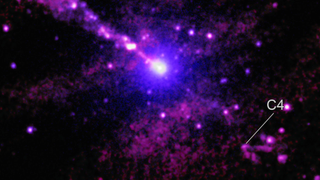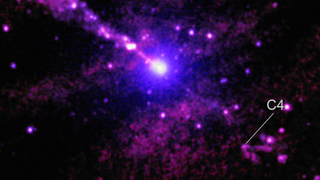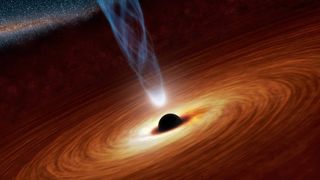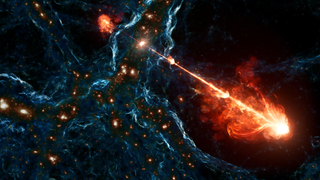Now Reading: Galaxy-size jet from monster black hole blasts mystery object in deep space (video)
-
01
Galaxy-size jet from monster black hole blasts mystery object in deep space (video)
Galaxy-size jet from monster black hole blasts mystery object in deep space (video)

Astronomers using NASA’s Chandra X-ray space telescope have witnessed a massive black hole jet slam into an unknown object in space. Astronomers have seen black hole jets blasting cosmic objects before, but this one appears different from these events.
The discovery came in the form of a strange mark in the bright jet erupting from the supermassive black hole at the heart of the galaxy Centaurus A (Cen A), located about 12 million light-years from Earth. The new research also revealed that at several points along its galaxy-scale length, the jet of high-energy particles from this black hole is traveling at near-light speed.
Though the jet of Cen A’s supermassive black hole has been well-studied in the past, the Chandra data revealed something new and unexpected about this outflow.

The team found the emission that contects to a bright V-shaped source of X-rays in Cen A. This source has been labeled “C4,” and it is located close to the origin point of the black hole jet.
According to NASA, the “arms” of this V-shaped emission are around 700 light-years long. For context, that’s around 175 times the distance between the sun and the closest star to the solar system, Proxima Centauri.

What we know and what we don’t know about this black hole jet
Jets from supermassive black holes don’t come from the black holes themselves but from around them. These cosmic titans suggest that because they are marked by a boundary called an “event horizon,” at which not even light moves fast enough to escape. Nothing with mass can move as fast as light, which means nothing can escape a black hole.
Some black holes are surrounded by flattened clouds of gas and dust called “accretion disks” that gradually feed them. Not all this material is destined to fall into the maw of the central black hole, however, as black holes are “messy eaters.”
This is because powerful magnetic fields around the black hole can channel matter to its poles. From there, these particles are accelerated to high speeds and high energies and are blasted out as astrophysical jets that can stretch out for millions of light-years.

While astronomers have a good idea about the physics that launch the jet from the supermassive black holes at the heart of Cen A, they don’t know what object it is they blasted. That is because it is too far away for even the most powerful current telescopes to distinguish in detail.
Related Stories:
This is not the first time that scientists have seen a black hole jet blasting an object in space. These other target objects have included clouds of gas and even unfortunate stars.
This collision stands distinct from those events because while they have produced elliptical “blobs” in X-ray images, this event created a v-shaped structure.
The team will now attempt to determine why this particular collision has produced a strange shape. This investigation will be conducted with Chandra, the only X-ray telescope currently sensitive enough to see this collision feature.
The team’s research is published in The Astrophysical Journal.
Stay Informed With the Latest & Most Important News
Previous Post
Next Post
-
 012024 in Review: Highlights from NASA in Silicon Valley
012024 in Review: Highlights from NASA in Silicon Valley -
 02Panasonic Leica Summilux DG 15mm f/1.7 ASPH review
02Panasonic Leica Summilux DG 15mm f/1.7 ASPH review -
 03From Polymerization-Enabled Folding and Assembly to Chemical Evolution: Key Processes for Emergence of Functional Polymers in the Origin of Life
03From Polymerization-Enabled Folding and Assembly to Chemical Evolution: Key Processes for Emergence of Functional Polymers in the Origin of Life -
 04How New NASA, India Earth Satellite NISAR Will See Earth
04How New NASA, India Earth Satellite NISAR Will See Earth -
 05And Thus Begins A New Year For Life On Earth
05And Thus Begins A New Year For Life On Earth -
 06Astronomy Activation Ambassadors: A New Era
06Astronomy Activation Ambassadors: A New Era -
07SpaceX launch surge helps set new global launch record in 2024




















